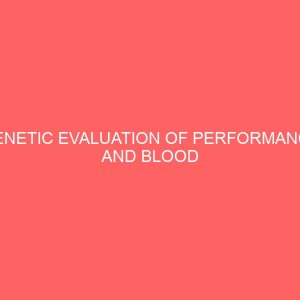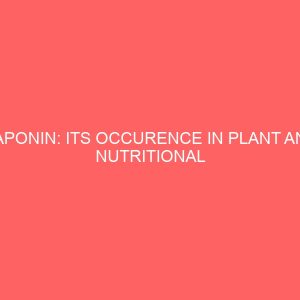Description
ABSTRACT
A study was conducted in a Northern Guinea Savannah region to evaluate the growth, reproductive and blood biochemistry parameters of parents and their offspring in Japanese quail. A total of two hundred and twenty Day-old chicks (DOC) were used in the base generation and six hundred and thirty DOC were used in the first generation. A digital scale of sensitivity (0.01 g) was used to take the weights. The body measurements taken were the 4-week body weight (BW4), 8-week body weight (BW8), overall average growth rate (Agr) and relative growth rate (Rgr). The reproductive parameters studied were the age at sexual maturity (ASM), weight at sexual maturity (WtAsm), egg weight at sexual maturity (EgAsm), average egg weight (Aveg), egg laid at the 11th week of age (Egg11) and the ratio of egg weight to 4-week body weight (EgB4), taken from female quails which were individually housed. In the 6th-week blood biochemistry studied, glucose (Glu) was measured according to Trinder, 1969 while Alkaline-Phosphatase (ALP) was determined according to Kind and King, 1954. For body weight, sexual dimorphism was observed within and across generations. In the base and first generation, the females and males showed no significant (P>0.01) difference for BW4 but the females had a significantly (P<0.01) higher BW8 than the males. In addition, the base generation had a significantly (P<0.01) higher BW4 and BW8 than the first generation. This difference observed in growth parameters had an effect on reproductive performance. The faster growing birds in the base generation were significantly (P<0.01) heavier in weight at sexual maturity and had a heavier egg weight but were significantly (P>0.01) lower for age at sexual maturity. The study on the blood biochemistry revealed that in each generation, the females and males showed no significant (P>0.01) difference for respective blood parameter; however, the first generation had a significantly (P<0.01) higher Glu but a significantly (P>0.01) lower ALP when compared to the base generation. The females had a higher coefficient of variation for the blood biochemistry when compared to those of the males in both generations. For this study it was observed that positive phenotypic correlation coefficient exists between growth rate and ASM. Reproductive traits are generally positively correlated while ALP and Glu are negatively correlated. The magnitude of repeatability estimates showed that the growth traits had higher inherent transmission ability than blood biochemistry and reproductive traits.
INTRODUCTION
Japanese quail (Coturnix coturnix Japonica) is an important livestock in Nigeria and in many nations. It is being farmed as the smallest avian species for meat and egg production (Panda and Singh, 1990). Its production is favoured because they are generally accepted, requires less time and space, have rapid growth, earlier sexual maturity, greater laying ability, shorter generation interval and resistance to diseases when compared to chickens. These peculiarities of coturnixs have facilitated its commercial production and rearing; mainly as meat in Europe, eggs in Japan and are often bred as dual-purpose birds in other Asian countries (Minvielle, 1998). They are also used as laboratory animals for researches (Baumgartner, 1994) and for extensive use in many studies (Kayang et al., 2004) such as for growth, selection and breeding. In Nigeria it is used for research purposes and commercially reared mainly for egg production.
Many researchers have focused their genetic studies on improving only economic traits. A broader perspective of improved and efficient genetic study has emerged because selection, breeding and genetic improvement have a marked effect on characteristics of the blood biochemistry; as researchers utilize the biochemical parameters of the blood as markers in livestock species to enhance productivity and reproductive performance (Emmerson, 2003; Nguyen and Tran, 2003). Genetic resources such as serum enzymes, serum proteins and bilirubin have been established as genetic markers in farm animals (Pagot, 1992). Several researches have shown the relationship between poultry birds’ performance and some blood parameters, these includes: plasma Alkaline Phosphatase activity in Rhode Island birds (Orunmuyi et al., 2007), the relationship between growth and blood constituents in Japanese quail by Faraht et al, (2010), and variation of plasma constituents at different ages of female Japanese quail (Hassan, 2010).







